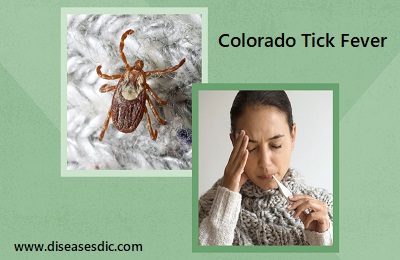What is Colorado Tick Fever?
Colorado tick fever (CTF), also known as Mountain tick fever or American mountain fever, is a viral disease caused by infection with the Colorado tick fever virus (CTFV), a member of the Coltivirus genera. CTF is transmitted to humans most commonly by the bite of an infected adult wood tick, and while there is no evidence of natural person-to-person transmission, rare cases of transmission by blood transfusion have been reported.
The diagnosis of persons with CTF is complicated by non-specific nature of the symptoms. Most persons experience fever, chills, headache, muscular and skeletal pain, and malaise; these signs and symptoms can be confused with other infectious and non-infectious diseases. A petehcial (spotted) rash occurs in 5-12% of CTF cases.
A closely related virus, Eyach virus, transmitted by the European sheep tick, Ixodes ricinus, has been reported in parts of Western Europe.
Pathophysiology and Etiology
The causative agent for Colorado tick fever is transmitted by tick bite. The agent is a double-stranded RNA virus of the genus Coltivirus in the family Reoviridae, the entire genome of which has been sequenced. CTF is the prototype virus from which the genus coltivirus derives its name (Colorado tick fever). Although the virus has been found in many tick species, the vector and major reservoir for CTF is D andersoni, also known as the Rocky Mountain wood tick. A closely related Coltivirus has been implicated in human disease in Europe, isolated from Ixodes ticks.
Symptoms of CTF typically begin 4-5 days after the tick bite, although incubation periods as long as 20 days have been reported. Free virus can be isolated from the blood for the first 2 weeks of illness. Following the initial period, the virus then circulates inside erythropoietic cells. The virus can live in a red blood cell for the life of the cell, which is approximately 120 days. Thus, blood donation from affected individuals is prohibited for 6 months after infection.
What Causes Colorado Tick Fever?
- CTF is caused by the Colorado tick fever virus.
- The virus is transmitted through the bite of an infected tick.
- The main carrier of the Colorado tick virus is the Rocky Mountain wood tick, which is most commonly found in the western United States. It usually lives in wooded areas located above 5,000 feet in elevation.
Risk factors of Colorado Tick Fever
- Factors that may increase your chances of Colorado tick fever:
- Living or traveling in mountain forest areas at altitudes above 5,000 feet in the western US (such as Colorado, Utah, Wyoming, Idaho, Montana, Oregon)
- Being in these areas between April and July
Symptoms
- The incubation period (time from tick bite to onset of illness) ranges from about 1 to 14 days.
- The most common symptoms of (CTF) are fever, chills, headache, body aches, and feeling tired. Some patients have sore throat, vomiting, abdominal pain, or skin rash.
- About half of patients have a “biphasic” fever. This means they have several days of fever, feel better for several days, and then have a second short period of fever and illness.
- Most people who become ill have mild disease and recover completely. However, weakness and fatigue may last several weeks.
- In rare cases, some patients may develop more severe illness that affects the central nervous system with symptoms that include stiff neck and confusion.
- Life-threatening illnesses or deaths due to CTF virus are rare.
What are the potential complications of Colorado Tick Fever?
CTF rarely causes complications. In some cases, however, the disease can lead to:
- Encephalitis, which is an inflammation of the brain tissue
- Meningitis, which is an inflammation of the membranes in the brain and spinal cord
- Hemorrhagic Fever, which damages the blood vessels as well as various organs
Hospitalization may be required if complications occur.
How is Colorado Tick Fever (CTF) diagnosed?
Your doctor can make a CTF diagnosis by doing a physical examination and performing various laboratory tests. These tests may include:
Complement Fixation Antibody Test
This test determines whether antibodies to the CTF virus are present in the blood. Antibodies are special proteins that help fight off harmful substances, such as bacteria and viruses. If antibodies to the Colorado tick fever virus are found, then a Colorado tick fever diagnosis is made.
Complete Blood Count
This is a broad screening test that measures the amount of white blood cells, red blood cells, and platelets in the body. It is a simple blood test that can help doctors determine the exact cause of symptoms.
Liver Function Tests
These tests evaluate how well the liver is working by measuring levels of proteins, liver enzymes, and bilirubin in the blood. Colorado tick fever can affect the liver, so impaired liver function may be a sign of the disease.
Treatment of Colorado Tick Fever
There are no specific treatments for this viral infection.
The provider will make sure the tick is fully removed from the skin.
Management of CTF includes treatment of fever and pain with analgesics and acetaminophen, along with standard infection control procedures.
You may be told to take a pain reliever if you need it. DO NOT give aspirin to a child who has the disease. Aspirin has been linked with Reye syndrome in children. It may also cause other problems in Colorado tick fever.
If complications develop, treatment will be aimed at controlling the symptoms.
Prevention and control
When walking or hiking in tick-infested areas:
- Wear closed shoes
- Wear long sleeves
- Tuck long pants into socks to protect the legs
Wear light-colored clothing, which shows ticks more easily than darker colors. This makes them easier to remove.
Check yourself and your pets frequently. If you find ticks, remove them right away by using tweezers, pulling carefully and steadily. Insect repellent may be helpful.

